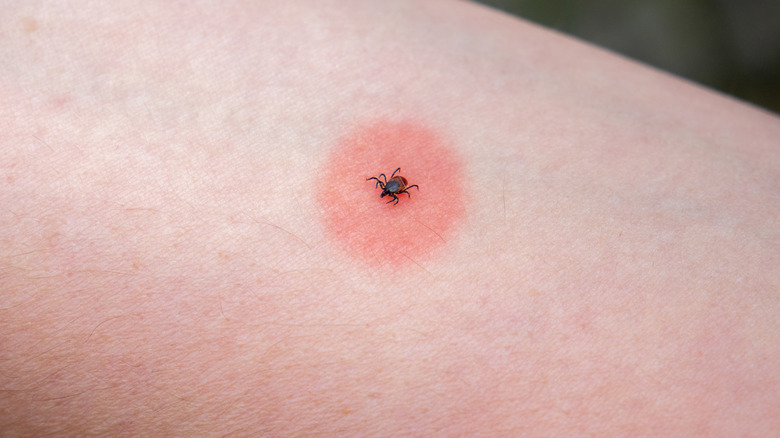When You Get Bitten By A Tick, Here's What Happens To Your Body
Ticks are tiny arachnids that belong to the suborder Ixodidae. They have evolved over millions of years to become efficient blood-feeders since blood serves as the tick's primary source of nutrition. With their specialized mouthparts, ticks are adept at latching onto humans and animals. Once they have attached to a host, ticks secrete a numbing agent into the skin to prevent detection, often making the sensation of a tick bite unnoticeable and all the more dangerous.
Ticks are commonly found in wooded areas, grassy fields, and areas with dense vegetation, which is why national parks advise visitors to take precautions to repel bugs when tenting or hiking through. These environments provide an abundance of potential hosts, such as mammals, birds, and reptiles, making it easier for ticks to find and feed on blood. Over time, they have made their way into urban settings, warranting caution even in gardening. These habitats offer shelter and protection for ticks during various stages of their life cycle, contributing to their evolutionary success.
Beyond the initial irritation at the bite site, ticks have the potential to transmit a variety of pathogens, including bacteria, viruses, and parasites, leading to a range of short-term and long-term effects. Keep reading to uncover a chronological breakdown of what happens to your body when bitten by a tick. By understanding the progression of symptoms and complications associated with tick-borne illnesses, we can better equip ourselves with knowledge for prevention, early detection, and treatment.
The body's initial response to pathogen transmission
When a tick bites you, regardless of whether it carries pathogens, your body's immune system springs into action to fend off the foreign intrusion. Our bodies are naturally equipped to recognize and combat such invaders, triggering a response upon detection. This response typically presents as redness, swelling, and itching at the bite site, similar to the reaction seen with other benign bug bites. Occasionally, individuals may even experience a localized allergic reaction, intensifying discomfort.
In the absence of pathogen transmission, the likelihood of experiencing short-term, medium-term, and long-term effects associated with tick-borne diseases diminishes significantly. Nonetheless, it's crucial to monitor the bite site for any signs of infection and seek medical attention if symptoms worsen or persist.
Conversely, if the tick carries pathogens, such as bacteria or viruses, they are transmitted into your bloodstream via the tick's saliva. This transmission triggers a cascade of immune responses aimed at identifying and neutralizing the invading pathogens. The specific type of pathogen and your individual immune response dictate the nature and severity of the effects on your health.
The initial skin reaction
After a tick bites you, it typically remains attached to your skin to continue feeding on your blood. They secrete a cement-like substance that helps them stay firmly attached so they can feed to the point of engorgement when they usually fall off. During this time, individuals may not always feel the tick due to the numbing agent they secrete. It's essential to inspect your body carefully, especially after spending time outdoors in areas where ticks are prevalent. Look for small, dark spots on the skin, which could indicate a tick bite.
Following a bite, some individuals develop a localized skin reaction, often appearing as a rash at the bite site. The rash's appearance can vary, ranging from a circular to an oval-shaped red patch with a central clearing, resembling a bull's-eye. While this characteristic rash pattern is commonly associated with Lyme disease, other tick-borne illnesses like Rocky Mountain spotted fever, ehrlichiosis, anaplasmosis, and babesiosis can also produce similar rashes. Therefore, the development of a rash serves as an early warning sign of potential infection and warrants further medical evaluation.
It's essential to note that even if the tick does not carry a pathogen, you may still experience a localized reaction at the bite site, akin to a spider or another bug bite. So, how do you differentiate between a benign reaction and a potential tick-borne illness? It's always wise to err on the side of caution and seek medical attention for appropriate evaluation and guidance.
Onset of joint pain
If you were bitten by a benign tick, symptoms rarely progress further than localized rashes or sensitivities. However, if a tick is carrying a pathogen, the consequences can be more severe.
Tick-borne illnesses can affect various systems within the body since pathogens can spread via the bloodstream or lymphatic system. One common symptom experienced by individuals with tick-borne diseases is joint pain. Pain may manifest as stiffness, swelling, or discomfort in one or more joints throughout the body. The onset of joint pain can occur days to weeks after a tick bite and may persist for an extended period, even after a tick has finished feeding and fallen off. This is what makes the detection and diagnosis of tick-related diseases so difficult.
Joint pain is a significant indicator of tick-borne diseases such as Lyme disease, but it can also accompany other conditions such as Rocky Mountain spotted fever or anaplasmosis. Therefore, if you experience sudden and unexplainable joint pain following an outdoor excursion where you may have been exposed to ticks, it's essential to seek medical attention promptly for evaluation and appropriate management. Early diagnosis and treatment can help prevent the progression of the disease and alleviate symptoms, improving your overall prognosis.
Emergence of neurological symptoms
As tick-borne pathogens spread throughout the body, they can directly invade nerve cells or travel along nerve fibers to reach the central nervous system, leading to the emergence of neurological symptoms. These symptoms may include tingling or numbness in the extremities, muscle weakness, cognitive difficulties, and headaches. In severe cases, individuals may experience paralysis, seizures, or altered mental status. The onset of neurological symptoms signifies the progression of the infection and indicates the need for urgent medical intervention to prevent further complications.
Neurological symptoms can vary depending on the type of tick-borne illness and the individual's immune response. For example, Lyme disease, caused by the bacterium Borrelia burgdorferi, is known to cause facial paralysis, meningitis, and encephalitis. In Rocky Mountain spotted fever, caused by the bacterium Rickettsia rickettsii, neurological symptoms may include confusion, reports a study in StatPearls. If left untreated, severe cases can progress to seizures, according to a case reported in the Nebraska Medical Journal.
As per a publication in Advances in Virus Research, tick-borne encephalitis, caused by flaviviruses, primarily affects the central nervous system, leading to inflammation of the brain (encephalitis). Symptoms can range from mild headache and fever to more severe manifestations such as meningitis, paralysis, and cognitive impairment.
Development of Lyme or tick-borne diseases
Untreated tick-borne diseases can have significant long-term consequences on the body, affecting multiple organ systems and leading to chronic health issues. Lyme disease, for example, is known for its potential to cause persistent joint inflammation and arthritis if left untreated. This can result in joint pain, swelling, stiffness, and reduced mobility, significantly impacting an individual's quality of life.
Additionally, certain tick-borne diseases can affect the heart, leading to conditions such as myocarditis (inflammation of the heart muscle), pericarditis (inflammation of the heart lining), and arrhythmias (irregular heart rhythms), as reported in a publication in Circulation. These cardiac complications can increase the risk of heart failure and other serious cardiovascular problems. Tick-borne diseases can also have long-lasting effects on the nervous system, leading to chronic neurological symptoms such as neuropathy (nerve damage), cognitive impairment, memory problems, and mood disorders. In severe cases, individuals may experience debilitating conditions such as chronic fatigue syndrome or fibromyalgia.
Some individuals with Lyme disease may experience persistent symptoms even after completing antibiotic treatment, a condition known as post-treatment Lyme disease syndrome (PTLDS). These symptoms can include fatigue, musculoskeletal pain, cognitive difficulties, and sleep disturbances, lasting for months or even years after the initial infection. Overall, the long-term consequences of untreated tick-borne diseases can be debilitating and often require ongoing medical management and support.





